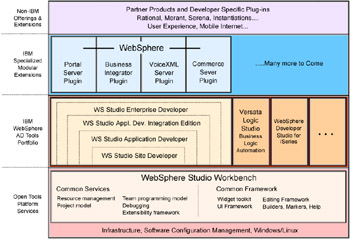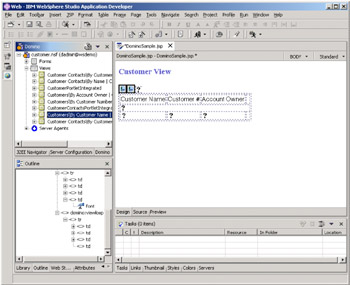4.3 Software and tools used
|
| < Day Day Up > |
|
4.3 Software and tools used
As we discuss the examples, we refer to several tools available to developers. Some of them are:
-
Lotus Domino Designer 6
-
WebSphere Studio Application Developer 5
-
WebSphere Portal Toolkit for WebSphere Studio
-
Lotus Domino Toolkit for WebSphere Studio
Since we discussed the Lotus Domino Designer in previous chapters, we will focus on reviewing the other tools available in this chapter.
4.3.1 WebSphere Studio Application Developer 5
WebSphere Studio Application Developer is one of the WebSphere Studio family of products that has been developed based on the Eclipse Workbench.
The Eclipse Workbench is an open source development platform, designed by IBM and released to the open source community. It is an open, portable, universal tooling platform that provides frameworks, services and tools for building tools.
In essence the workbench provides the tool infrastructure. With this infrastructure in place, the tool builders are able to focus on the actual building of their tools. The workbench has been designed for maximum flexibility to support the development of tools for new technologies that may emerge in the future.
Development tools written for the workbench should support a role-based development model, in which the outcomes of the developers' work will be consistent. The developers should not have to be concerned with how different individual tools may be treating their files.
The WebSphere Studio family of products is an integrated platform (IDE) for developing, testing, debugging, and deploying J2EE applications. It provides support for each phase of the application development life cycle.
WebSphere Studio Application Developer 5 includes the following tools:
-
Web development tools
-
Jakarta Struts development tools
-
Enterprise Java Beans development tools
-
Relational database tools
-
XML tools
-
Java development tools
-
Web services development tools
-
Team collaboration tools
-
Integrated debugger for JSPs, Servlets, EJBs and Java code
-
Server tools for testing and development
-
Performance profiling tools
-
Plug-in development tools
-
Integration with automated build tools like ANT
-
Unit test tools like JUnit
The WebSphere Studio Application Developer has many features to assist the developer; some are illustrated in Figure 4-5. Within the framework there are development perspectives that let you invoke the tools without losing the reference to the working object. In addition, the framework is extendable, allowing you to plug in other tools like WebSphere Portal Toolkit for WebSphere Studio and Lotus Domino Toolkit for WebSphere Studio.

Figure 4-5: WebSphere Studio internal structure
As the figure shows, the WebSphere Studio tool is constructed of building blocks. The cornerstone of the structure is the Eclipse Framework, and on top of it IBM WebSphere Studio Workbench is the basic framework on which several flavors of the WebSphere Studio products are supported.
The first item in the WebSphere Studio portfolio is WebSphere Studio Site Developer, which provides support for creating Web applications and Web services projects and utilizes the broad number of services provided by the WebSphere Studio Workbench.
Next is WebSphere Studio Application Developer, which gives the developer a full J2EE environment for developing enterprise applications.
On top of it, the WebSphere Studio Application Developer Integration Edition delivers a full environment for developing JCA adapters and enterprise services provided by the WebSphere Application Server Enterprise Edition.
Finally, the top of the line tool is the WebSphere Studio Enterprise Developer, which gives the traditional Cobol, CICS® developer an environment for developing legacy applications, along with the new EGL language, which helps develop enterprise applications on a 4GL environment.
The WebSphere Studio family comes with excellent tools to visually build JSP interfaces and construct visually the logic of Web applications using the Jakarta Struts framework. The Struts framework and how it fits in the Portal environment is discussed in the next chapter.

Figure 4-6: Snapshot of WebSphere Studio Application Developer
For more information on WebSphere Studio Application Developer 5 refer to the references at the end of this chapter.
4.3.2 WebSphere Portal Toolkit for WebSphere Studio 4.2.5
The WebSphere Portal Toolkit is designed to help you develop portlet applications for WebSphere Portal Version 4.2 and later versions. Everyplace® Toolkit is designed to help you develop mobile e-business applications for WebSphere Everyplace Access Version 4.2 and later versions, in addition to aiding portlet application development. Portal Toolkit or Everyplace Toolkit provides the following tools for use in developing your portlet applications:
-
Portlet project
-
Portlet application examples
-
Portlet perspective
-
New portlet application wizard
-
portlet.xml editor
-
Portal configuration
-
Exporting to the Web Archive (WAR) file

Figure 4-7: WebSphere Portal Toolkit for WebSphere Studio
For the latest information on the toolkit, and for downloadable upgrades and fixes, check the following Web site:
http://www.ibm.com/websphere/portal/toolkit
4.3.3 Lotus Domino Toolkit for WebSphere Studio 1.0
The Lotus Domino Toolkit for WebSphere Studio is a plug-in for WebSphere Studio 5. Currently the Lotus Domino Toolkit for WebSphere Studio ships with Lotus Domino Designer 6.0.2. It allows you to add Domino 6 custom tags to Java server pages, providing a simple way to blend Domino and J2EE applications. JSP tags are XML tags embedded in a JSP providing data access, data input, and process control. The tags abstract the Domino objects for Java (Domino Java API) and provide quick development turnaround for building J2EE applications that use Domino data and services.
The toolkit provides a dedicated pane in WebSphere Studio where you open the Domino database you wish to work with. The pane displays the views, columns, forms, fields, and Domino server agents in the database, and provides two quick ways of putting Domino tags into your page. You can:
-
Right-click an item and choose Add to Web Page from the Context menu
-
Drag and drop an item directly into the page
Either of these operations will paste a tag representation of the item into the editor at the current cursor position. Of course, if you prefer, you can add the tags manually in the editor.

Figure 4-8: Lotus Domino Toolkit for WebSphere Studio 1.0
How it fits in to the Lotus technology strategy
To understand the Lotus technology strategy, and how it applies to Domino applications and their development, envision a multi-lane superhighway with a Lotus Domino lane, a WebSphere lane, and a next generation lane. The Lotus Domino lane continues as far as the eye can see and runs parallel to the WebSphere lane, which also continues as far as the eye can see. The next generation lane merges with the other two lanes at a point in the future.
In the Lotus Domino lane, the Domino collaborative application development and deployment environment enables you to develop applications quickly and to take them off-line, bringing people, processes, and data together to facilitate both productivity in e-business and quick decision-making. Lotus will continue the current Domino application development model and data store (NSF) and in the future, will enhance it to meet customer and developer requirements. As is the IBM tradition, Lotus Notes and Domino customers will benefit from comprehensive support for the foreseeable future. Additionally, Lotus Domino will increase its support of the Java 2 Platform, Enterprise Edition (J2EE) and infrastructure standards, such as Java Server Page (JSP) tags, Java APIs, LDAP, and RDB integration to assist developers interested in working in both the Domino and WebSphere lanes of the superhighway.
In the WebSphere lane, the J2EE specification is leveraged as the application development platform. J2EE provides a specific architecture for building, deploying, and managing applications in multiple tiers, often broken into presentation, logic, and data. This architecture is designed to provide scalability, flexibility, and manageability. While J2EE is a rich application development platform, it has very few features to support collaboration, so it benefits from having Lotus Domino to provide rich collaborative capabilities. Applications designed to use the Lotus Domino and WebSphere lanes blend powerful collaborative features with significant transactional scalability to deliver end-to-end e-business solutions.
|
| < Day Day Up > |
|
EAN: 2147483647
Pages: 103